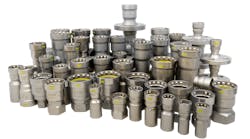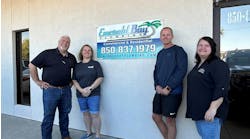MELBOURNE, FLA. — The Melbourne Health and Rehabilitation Center was facing a crisis. Two of the facility's three 100-gal. tank-type commercial water heaters were beginning to fail. The 180-bed nursing facility runs its laundry and kitchen around the clock; two 75-lb. washing machines operate from 5:00 AM to 11:30 PM, while the kitchen requires hot water for three meals a day with two multi-bay sinks and a dishwasher. A solution needed to be found, and quickly.
Facility Maintenance Director Paul Brezina chose to view the moment as an opportunity to introduce a new, high-efficiency tankless hot water system. “I was once a pipefitter,” Brezina said, “and had installed tankless water heaters myself, so I knew they were good. With the tank-type heaters, we were never satisfied with the hot-water supply.”
To get the work done, Brezina called Sun Plumbing. The Melbourne-based company has been in business for 35 years, and has had a working relationship with the Health and Rehabilitation Center for the past 10. The company services much of Brevard County out on the Space Coast of Florida, just south of Cape Canaveral.
“We do everything from plumbing repair, service work to septic tank install and septic tank lift stations,” said Paul Webb, service manager for Sun Plumbing. “We have a remodel department, a new construction department, just all aspects of plumbing.”
The contractor keeps about seven technicians on staff.
Webb's first job was to go back to the office and calculate the flow rates at various points-of-use.
“I had to crunch some numbers to figure out how many units they needed to fit their application,” Webb said, “then I got with Rheem and some of our local distributors here and we put together a package.”
That package consisted of six Rheem GT-199PVN-1 tankless units in a manifold configuration. Now the only problem was making the switch from old system to new while keeping the hot water flowing.
Over a three day period, Webb and his crew did just that. Originally, the facility owners wanted the new heaters installed on the roof to save on venting costs. Sun's crew ultimately installed them in the 12-ft. by 8-ft. mechanical room that housed the three tank-type heaters.
First, Webb's crew took out two of the old heaters — which gave them enough space to hang the tankless units — while leaving the third running. Once the new units were piped in they were able to take the last unit out.
“Over the course of the entire installation, they were only shut down for about eight hours,” said Webb.
To run the flue vents for each tankless unit, Webb and his technicians had to core drill through the building's concrete roof.
“The work went really smoothly,” Webb said. “I was happy with how it all came together.”
Even getting rid of the old water heaters was straightforward since the mechanical room was right next to the building's service driveway.
“We didn't have to haul them through hallways or anything,” Webb noted. “That was nice.”
The installation has resulted in dramatic cost savings. In February, March and April 2008, the center's gas bills were $4,100, $3,700 and $3,900, respectively — $11,700 total. Fast-forward to 2009, following the conversion to tankless, and the charges for February, March and April were $1,500, $700, and $1,350, respectively — $3,550 total. That calculates into a year-on-year savings of $8,150, or nearly 70%.
Total cost for the job was $26,426, which included the flue and other piping. But with the savings already achieved to date, Brezina figures to recoup that expense quickly: “Tankless heaters cost more at the front end, but at this rate, ours will probably pay for themselves within a year.”
Webb is looking to parley the success of the conversion into more work down the road — the parent company of West Melbourne Health and Rehabilitation operates four other nursing homes in Florida.
“We're trying to get our foot in the door with them,” he said.
With those kinds of savings to point to, he's got a very strong case to make.

